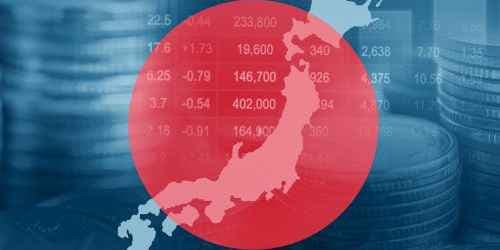
10Y JGB Yield No Longer Pricing in BOJ Policy Adjustment
 ACY Securities - Luca Santos
ACY Securities - Luca Santos
If the net domestic fund demand remains at approximately the current level of -0.4%, and the Bank of Japan (BoJ) acquires JPY7 trillion worth of Japanese Government Bonds (JGBs), the macro fair value for the 10-year JGB would hover around 0.7%. The current 10-year JGB yield in the market, remaining close to the macro fair value, suggests that it adequately incorporates the additional downward pressure on yields imposed by the BoJ's commitment to the existing easing framework. In essence, the current pricing reflects an absence of expectations for any imminent changes in the Yield Curve Control (YCC) or negative interest rate policy.
JP10Y

Source: TradingView
In November, the core-core Consumer Price Index (CPI) for Tokyo, excluding fresh food and energy, showed no growth, further decelerating compared to October. The weakening household fundamentals likely heightened households' sensitivity to price fluctuations. Over a 3-month period, the Tokyo core-core CPI decelerated from over 4% in March-April to 2.2% as of November. If the core-core CPI increases by only 0.1% month-on-month in December, it would fall below the BoJ's 2% target on a 3-month basis.
Japan CPI

Source: Finlogix Calendar
In the event of a slowdown in the US economy prompting the Federal Reserve to reduce its policy rate, the Japanese Yen (JPY) is likely to experience strong appreciation pressures. The BoJ has previously failed to fully lift Japan out of deflation by tightening policy during the global economic peak. The government may not declare victory in overcoming deflation until the corporate savings rate becomes negative, and structural deflationary forces vanish. Exiting the current monetary easing policies may not be feasible for the BoJ until these conditions are met.
Initiating the policy tightening process before inflation expectations rise sufficiently to sustain 2% inflation and in the face of a slowing global economy increases the risk of Japan slipping back into deflation. This scenario could result in a significant decline in long-term yields, mirroring past mistakes of tightening monetary policy at the global economic peak and failing to completely eradicate deflation in Japan.
Failing to lift Japan out of deflation for a third time would likely invite criticism from the government, especially given the central bank's commitment to overcoming deflation.
The modelling of 10-year Japanese Government Bond (JGB) yields involves various factors such as net domestic fund demand (as a percentage of GDP), the Bank of Japan's (BoJ) policy interest rate (call rate), the BoJ's long-term government bond purchases (as a percentage of GDP), the US 10-year government bond yield, and a dummy variable representing the negative interest rate and Yield Curve Control (YCC) policy framework (0 before Q425, 1 after Q116). Using these variables, the macro fair value of the 10-year JGB yield can be calculated on a quarterly basis since 1990. The formula is as follows:
10YJGByield (%) = 0.26 + 0.69 Domestic O / N interbank call rate + 0.2710YUSTyield (%) − 0.04Net domestic fund demand (%GDP) − 0.02BoJJ GB purchases (annualized rate, % GDP) − 0.40NIRP・YCC dummy + 0.51 Up dummy −0.45 Down dummy; R2= 0.99
Given the decline in US treasury yields, the BoJ is reducing its monthly purchases of JGBs from JPY9 trillion to JPY7 trillion to ease the strain on the JGB market caused by the existing monetary easing program. The BoJ, committed to expanding the monetary base until the 2% inflation target is achieved, is unlikely to decrease JGB purchases below JPY6 trillion, accounting for the redemption of JGBs held by the central bank.
Assuming net domestic fund demand remains at the current level of -0.4% and the BoJ purchases JPY7 trillion of JGBs, the macro fair value of the 10-year JGB yield would be approximately 0.7%. The current market 10-year JGB yield staying close to the macro fair value indicates that it fully incorporates the additional downward pressure on yields exerted by the BoJ through its commitment to the current easing framework. In simpler terms, the existing pricing reflects no expectations of changes in the Yield Curve Control or negative interest rate policy soon. This conclusion holds, even considering market expectations related to the government's economic stimulus package of around JPY17 trillion (3% of GDP) and a potential return of BoJ purchases to around JPY9 trillion per annum.
In November, the Tokyo core-core Consumer Price Index (CPI), excluding fresh food and energy, recorded zero growth, further decelerating compared to October. Deteriorating household fundamentals likely increased sensitivity to price changes, leading households to respond more strongly to price increases by reducing consumption. Over a 3-month period, the Tokyo core-core CPI decelerated from over 4% in March-April to 2.2% in November. Retailers might consider lowering prices to stimulate demand during the holiday season, potentially causing core-core CPI to fall below the BoJ's 2% target on a 3-month basis if it grows by only 0.1% month-on-month in December.
A potential slowdown in the US economy and a Fed policy rate cut could result in strong appreciation pressures on the Japanese Yen (JPY). A strengthened JPY increases the risk of the economy falling into deflation. The BoJ's previous attempts to lift Japan out of deflation by tightening policy during the global economic peak have been unsuccessful. The government is unlikely to declare victory over deflation until the corporate savings rate turns negative and structural deflationary forces dissipate. Exiting the current monetary easing policies is expected to be challenging for the BoJ until these conditions are met.
Initiating the policy tightening process before inflation expectations are sufficiently elevated and in the face of a global economic slowdown increases the risk of Japan falling back into deflation. This scenario could lead to a significant decline in long-term yields, repeating mistakes made by the central bank in previous decades, including tightening monetary policy at the global economic peak and failing to eliminate deflation in Japan. Failing to pull Japan out of deflation for a third time is likely to invite criticism from the government, especially given the central bank's commitment to overcoming deflation. Recent statements from BoJ policy board members indicate a growing awareness of such concerns within the central bank.
This content may have been written by a third party. ACY makes no representation or warranty and assumes no liability as to the accuracy or completeness of the information provided, nor any loss arising from any investment based on a recommendation, forecast or other information supplied by any third-party. This content is information only, and does not constitute financial, investment or other advice on which you can rely.
LiquidityFinder
LiquidityFinder was created to take the friction out of the process of sourcing Business to Business (B2B) liquidity; to become the central reference point for liquidity in OTC electronic markets, and the means to access them. Our mission is to provide streamlined modern solutions and share valuable insight and knowledge that benefit our users.
If you would like to contribute to our website or wish to contact us, please click here or you can email us directly at press@liquidityfinder.com.
